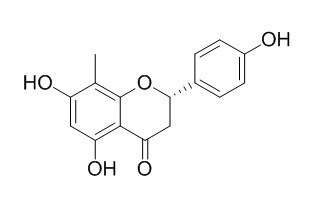5,7,4'-Trihydroxy-8-methylflavanone
Reference standards.
Inquire / Order:
manager@chemfaces.com
Technical Inquiries:
service@chemfaces.com
Tel:
+86-27-84237783
Fax:
+86-27-84254680
Address:
1 Building, No. 83, CheCheng Rd., Wuhan Economic and Technological Development Zone, Wuhan, Hubei 430056, PRC
Providing storage is as stated on the product vial and the vial is kept tightly sealed, the product can be stored for up to
24 months(2-8C).
Wherever possible, you should prepare and use solutions on the same day. However, if you need to make up stock solutions in advance, we recommend that you store the solution as aliquots in tightly sealed vials at -20C. Generally, these will be useable for up to two weeks. Before use, and prior to opening the vial we recommend that you allow your product to equilibrate to room temperature for at least 1 hour.
Need more advice on solubility, usage and handling? Please email to: service@chemfaces.com
The packaging of the product may have turned upside down during transportation, resulting in the natural compounds adhering to the neck or cap of the vial. take the vial out of its packaging and gently shake to let the compounds fall to the bottom of the vial. for liquid products, centrifuge at 200-500 RPM to gather the liquid at the bottom of the vial. try to avoid loss or contamination during handling.
Evid Based Complement Alternat Med.2017, 2017:1401279
Medicina (Kaunas).2020, 56(12):685.
Int J Mol Sci.2021, 22(19):10220.
Horticulture Research2022, uhac276.
Planta Med.2023, a-2192-2281.
Analytical methods2019, 11(6)
J. Pharm. Biomed. Anal.2024, 245:116193.
Sci Rep. 2018, 1-9
Pak J Pharm Sci.2019, 32(6):2879-2885
Foods.2023, 12(12):2412.
Related and Featured Products
Chinese Traditional & Herbal Drugs, 2010 , 41 (1) :19-23.
Chemical constituents from Rhododendron spiciferum and their effects on immunocyte of mice.[Reference:
WebLink]
To study the chemical constituents from the leaves of Rhododendron spiciferum and their immunomodulatory activities.
METHODS AND RESULTS:
The chemical constituents were isolated by various chromatography techniques and their structures were elucidated on the basis of spectroscopic data. The immunomodulatory activity of some compounds was examined by Balb/c mouse spleen lymphocyte proliferation through MTT. Twelve known flavonoids were isolated and identified as: quercetin-3-O-α-L-ara-binfuranside (1), quercetin-3-O-α-L-rhamnopyranoside (2), trans-taxifolin-3-O-α- arabinopyranoside (3), astilbin (4), 3-Orhamnoside engeletin (5), naringenin (6), (2S)-5,7,4'-Trihydroxy-8-methylflavanone (7), epicatechin- (2β→O→7,4β→8)-ent-epicatechin (8), proanthocyanidin A-l (9), bis-8, 8′-catechiny-lmethane (10), catechin (11), and epicatechin (12). The results showed that compounds 8, 9, and 11 alone or combined with ConA or LPS could significantly enhance the proliferation of spleen lymphocytes in a certain dose range.
CONCLUSIONS:
This is the first report on the chemical constituents from R. spiciferum. Compounds 8,9, and 11 are found to be effect on increasing immunomodulatory activity.



